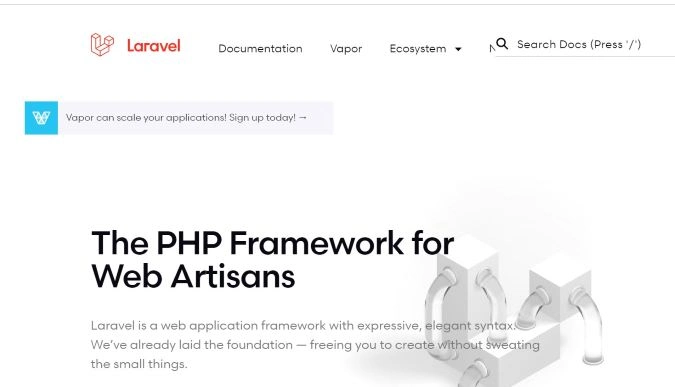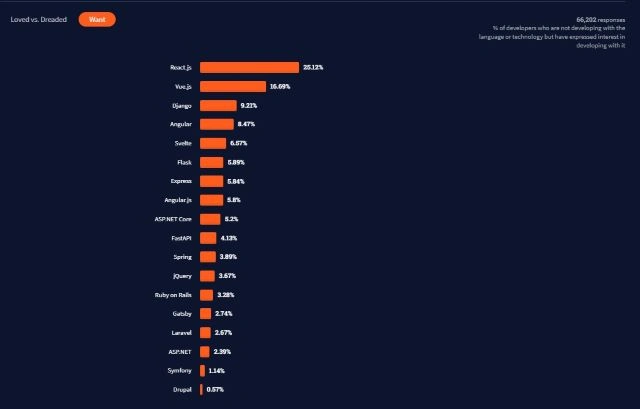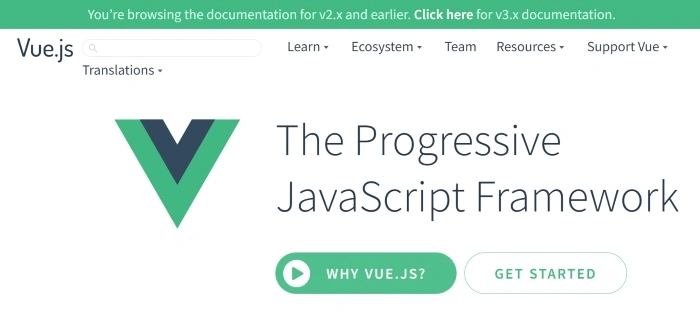What purpose does a Software Framework (e.g., Front End Framework) serve?
Framework, Web Frameworks, Web App Framework are defined as types of structures, software frameworks, and sets of tools used to create web applications, web pages, web services, web resources, or web APIs.
Of course, Frameworks are not only used to build web applications but also desktop applications, microservices, and data science, and can even create a whole ecosystem and infrastructure. They help fulfill the requirements of an ongoing project.
The number of available Frameworks allows you to choose the right tool that is appropriate for the needs of your current and even future projects.
That is compatible with personal preferences and provides not only comfort of work but increases its efficiency, effectiveness, safety, and tangibility.
Why have Frameworks become so popular and indispensable in building applications, performing certain tasks, and creating digital products?
Why exactly do developers consider Frameworks as essential tools?
Do Frameworks allow you to create a structure of an application or provide a finished application faster?
What are the advantages of Frameworks? What types of these tools can we distinguish? What is the difference between Frameworks and Libraries?
You can find the answers to these questions in the following paragraphs.
We invite you to read further!
What is a Framework?
What is a Framework? In the dictionary definition, the term Framework means a structure, skeleton, model, or context.
This linguistic meaning of the Framework very well coincides with the functional, technological sense contained in this term regarding mobile application development, web application development, or Computer Science in general.

The term Framework can also be defined as a real or conceptual structure, a general mechanism, which is intended to be a support or a guide for building something (such as web applications) that extends the initial structure into something:
- useful
- functional
- meeting business requirements
- related to the User Experience (UX Framework)
Frameworks are a type of support software. Thanks to it, the developer creates an application, which is used for faster, more secure (using frameworks reduces the number of errors and vulnerabilities in applications), convenient, and efficient creation of an application.
The essence and main advantage of Frameworks (that are usually multipurpose solutions) is the ability to develop web applications and mobile applications using ready-made resources (e.g., libraries, reference documents), components, and templates.
In practice, the application isn't entirely created from scratch and eliminates the age-old problem of reinventing the wheel.
Frameworks don't only provide access to ready-made solutions but also allow for their flexible use to meet your needs, which will inevitably vary when developing applications.
It's also worth mentioning how a Framework is created, as this is an important argument in its favor.
Frameworks are usually a collective effort. They are improved, optimized, and tested by a vast, typically international, community of developers. They most often make the results of their work available under an open-source license.
In most cases, an open-source Framework can be used for commercial purposes without paying for expensive licenses.
Thanks to the contributions of various specialists, who are heavily involved in their development, Frameworks are tools appreciated for their reliability, performance, stability, usability, and versatility.

As a product of “collective intelligence”, they are bound to be far more refined, reliable, flawless, and relevant to changing market and technological needs than commercial solutions, which respond to changes much more slowly.
What are the advantages of using Software Frameworks?
Creating web applications is a complex, multi-stage, time-consuming process requiring the use of a variety of technologies.
It needs the involvement of various specialists and is most often carried out in one of the Agile methodologies (e.g., Scrum Framework).
Software development requires, among other things, work related to coding, design, research, and testing.

The ability to use ready-made solutions, practices, models, and tools that increase control over the entire software development process is a tangible benefit in terms of:
- programming time
- budget
- organization
- performance
- the course and atmosphere of work within a given project
The main advantages of Frameworks include:
- ability to use proven models, practices, methods, solutions, and tools
- increased security and decreased number of vulnerabilities and bugs in a code
- increased code consistency, clarity, and conciseness (Frameworks allow you to avoid duplication of code)
- increased sense of control over code, design, progress, and changes, especially in projects with high levels of complexity and technological sophistication
- increased reliability of the developed application
- faster and much easier code debugging
- more efficient code testing
- ability to use components by different developers – in particular, this allows you to delegate tasks within the project in accordance with competencies, experience, skills, and roles in the project
- possibility to reuse a fragment of code with the feeling that you are using a safe, tested, and adequate code
- ability to customize the Framework to implement functional and business requirements
- ability to invest in tasks, goals, and effects, not technology
Creating web applications with the use of Frameworks also has the advantage of devoting more time and attention to developing the application's key functionalities.
What are the four types of Frameworks?
We can look at types of Frameworks from several sides, these types apply some of the most important criteria for division.
We can divide Frameworks based on the:
- specific programming languages (e.g., JavaScript Framework, Java, Python Framework)
- range of the offered tools and solutions (Full-Stack Framework, Microframework)
- layer for which they are dedicated (Front-End Framework, Backend Framework)
- type of application being developed (e.g., web applications, web applications)
- tasks and goals they allow you to perform and achieve (e.g., Testing Framework that reduces the cost of maintenance and code testing)
Server-Side Frameworks / Backend Frameworks

Backend Frameworks are used to create the backend of applications and help developers make applications more accessible to users.
Backend Frameworks are also the most commonly used types of Frameworks. Some of the most popular examples include Ruby on Rails, Django Framework, Flask, Laravel, and Express.JS.
Along with their appearance, application development methods have also changed completely.
To begin, significant automation of typical tasks and work has taken place (e.g., session management, handling of web search queries and responses).
Backend Frameworks have realistically and measurably accelerated the application development process.
There is more to it than that. Frameworks also offer:
- scalability
- increased reliability
- increased security
- easier integration of applications with external systems
- creating complex and feature-rich database-driven applications
- flexibility
- easier access to relational databases
- maintenance tools
- easier performance of a variety of tests
- acceleration of the business logic implementation
- improved separation of Front-End and Backend layers
Client-Side Frameworks / Front-End Frameworks
In general terms, Front-End Frameworks are used to design what users see and interact with when using an application.
Front-End Frameworks provide developers with proven, tested tools for creating scalable and interactive applications.
The most famous examples of Front-End Frameworks include Next.js, Angular JS, and Vue.js.
The most significant advantages of Front-End Frameworks include:
- ability to create interactive applications
- ability to create responsive applications
- shorter product development time
- easier creation of stable user interfaces
- offloading the server layer by moving a lot of business logic to the user's browser
Infrastructure Frameworks
With the development of cloud computing and distributed applications based on microservices, a new type of Framework has recently appeared on the market. They focus primarily on the aspect of complex application infrastructure in the cloud and solving typical problems of distributed systems.
This type of Framework allows you to easily integrate with your cloud computing provider, create an infrastructure based on programming code (Infrastructure as a Code) and significantly increase cloud application security.
We can name AWS Amplify or Google Firebase solutions among the typical representatives of this type (Serverless Framework).
How to choose a right Framework?
When developing any application, the question of choosing the right, most suitable, and useful Framework will naturally arise. What features should a good Framework possess?

Of course, such criteria can be established at a very general level.
Nevertheless, their fulfillment will certainly help to distinguish a solution that will be convenient, helpful, and adequate from the one that won't be able to provide enough efficiency, quality, and satisfaction.
If you want to choose a good Framework, it is important to pay attention to the:
- availability of specialists on the labor market
- ease of its implementation
- ease of use
- consistency
- purity, conciseness, and clarity of the code that it creates, deprived of any redundant code
- compliance with best practices, templates, and standards
- flexibility and adaptability to individual needs
- ability to create your own reusable components
- set of offered functionalities, primarily their adequacy to the needs of the specific project (e.g., Full-Stack Framework vs. Microframework)
- consistency in organization and production in regard to the distribution and flow of work
- availability of well documented code and educational materials, allowing you to quickly learn how it works
- community centered around a given Framework – its size, activity, engagement, productivity (e.g., number of versions and patches that are introduced)
- ability to expand and maintain the code
Library and Framework – the difference between a Software Framework and a Software Library

Software Framework and Software Library how do they differ? The word Framework is often accompanied by another term which, unfortunately, is mistakenly taken as its synonym. I am referring to a Software Library, of course. Using these terms interchangeably, while popular, is not correct.
A Software Library, unlike Framework, is usually used to solve one or a set of technical problems as well as to eliminate routine tasks.
We won't find Software Libraries designed to create complex business logic. Libraries perform specialized tasks and focus on a narrow area of operation.
They are the bricks from which we develop software (including Frameworks).
For example, libraries can be responsible for tasks such as:
- photo editing
- complex mathematical operations
- support for HTTP requests
- cryptography
- unusual components of the user interface
In contrast to the Library, the Framework allows you to comprehensively create the entire software, build business logic and combine multiple layers of software into one coherent whole.
The majority of Frameworks accompany developers throughout the software life cycle.
Microframeworks, which are responsible for a very narrow section of an application, but at the same time are not Libraries, deserve special attention.
Here, the line between the Library and Microframework is negotiable.
For example, the developers of React Native call their work a Library, although in our opinion it is a Microframework, which with the help of additional libraries can be expanded to the level of a Full-Stack Framework.
What is a Framework in simple terms? Summary
- What is a Framework in programming? It's the creation of web and mobile applications. It is a complex, multi-stage, time-consuming process requiring various technologies, methodologies, tools, and competencies.
- Among other things, it needs work related to coding, design, research, and testing. Frameworks (their set of functions) and a collection of Libraries provide time savings on all this work and alleviate the workload for the programmer to a large extent.
- Frameworks provide invaluable support tools throughout the application development process (mobile development frameworks and web development frameworks).
- A Framework is a type of structure (real or conceptual), a software frame used in developing software applications.
- A large selection of Frameworks allows you to choose the most appropriate tool that's adapted to current design needs and useful in programming and matches the experience of the programmer using them.
- Frameworks allow you to increase the comfort, efficiency, effectiveness, and measurability of work.
- They are often multipurpose software that allows you to create web and mobile applications using ready-made resources, components, and templates.
- The most popular Frameworks are constantly improved, optimized, tested, and made available under open source license by the active community of software developers.
- Thanks to the open-source Framework, developers can program applications faster. Offer safer, better, and more stable software to the users.
- Frameworks are appreciated primarily for their reliability, performance, stability, usability, and versatility. In addition, they are generally more refined, flawless, and responsive to changing market and technological needs than commercial solutions.
- The main advantages of Frameworks include the ability to use proven templates, practices, methods, and solutions.
- Security, higher code quality, an increased sense of control over the code and the project, greater reliability of the created application, and faster and much easier debugging of the code – these are other advantages of the Frameworks.
- Backend Frameworks are used to create the backend of applications and help developers make applications more accessible to users.
- Front-End Frameworks are used to design what users see and interact with when using an application.
- Infrastructure Frameworks allow you to easily integrate with your cloud computing provider, create an infrastructure based on programming code and significantly increase cloud application security.
- Libraries perform specialized tasks and focus on a narrow area of operation. They can be compared to bricks from which software is built (not excluding the Frameworks themselves).
- When choosing a Framework, you should pay special attention to the ease of implementation, purity, conciseness, clarity of the code it creates, compliance with best practices, templates, and standards, flexibility, and the ability to adapt to individual needs, as well as, organization and production regarding the division and flow of the work.




